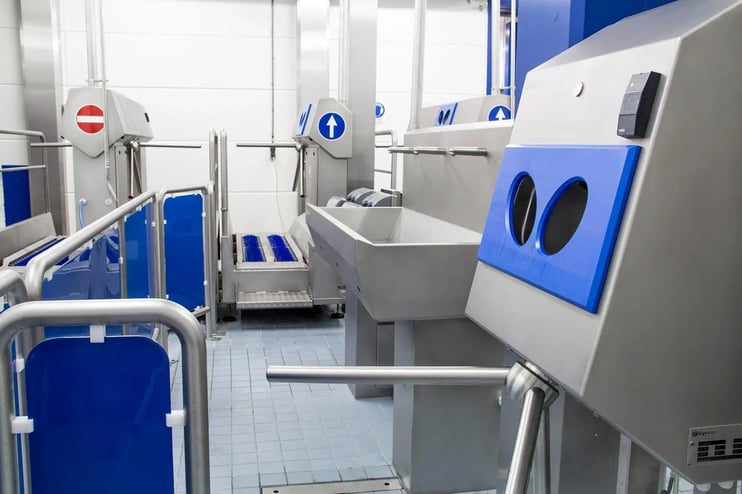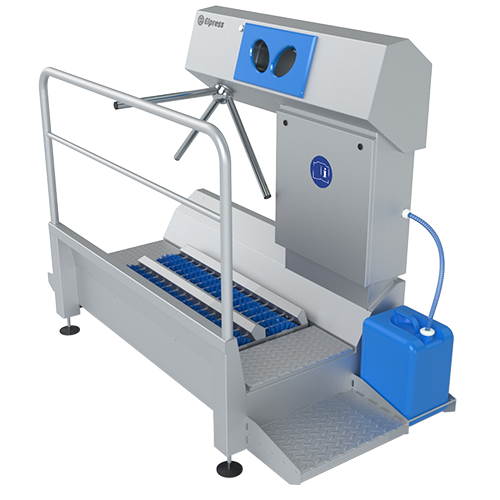How does a hygienic entrance work?

In the world of production and food processing, hygiene plays a crucial role. Minimizing the risk of contamination is not just a matter of regulation but also the moral and social responsibility of companies. A key component is the 'hygienic entrance'. A hygienic entrance is an innovative solution designed to ensure personal hygiene in environments where human contamination poses a significant risk. The hygienic entrance is usually located at the entrance of a company, ensuring compliance with hygiene requirements before anyone enters the workspace. In this blog, you will read about how a hygienic entrance exactly works.
Although the basic purpose of every hygienic entrance is the same - ensuring personal hygiene - there are numerous variations in design and functionality that meet specific needs. The most common functionalities of a hygienic entrance are:
- Hand washing
- Hand drying
- Hand disinfection
- Sole cleaning
- Sole disinfection
- Shaft cleaning
This variety of functions shows how hygienic entrances can be adapted to meet the specific requirements of different production environments.
Operation of the hygienic entrance: automatic and efficient
A hygienic entrance is not just a passage, but an advanced system that automatically activates as soon as an employee enters it. Sensors detect the presence of a person, and the hygiene process is initiated. This process depends on the model of the hygienic entrance, but the core functions remain the same: cleaning and/or disinfecting hands and soles. View all hygienic entrances by Elpress here.
Cleaning of hands and soles in the hygienic entrance
As mentioned, the hygienic entrance addresses two primary contact points: hands and soles. When hands are inserted into the cylinders, sensors activate the spraying of disinfectant or soap. Then, the water jet is activated, and the user can wash their hands. This ensures thorough cleaning without physical contact. Thanks to sensors, excessive use of chemicals is prevented. In certain hygienic entrances, disinfecting hands is the main function, without a preceding washing process. In some cases, hand cleaning begins with washing under running water. Then, hands can be dried with paper or a more efficient method like the Dyson Airblade. Parallel to hand cleaning, soles are cleaned. There are two common methods for sole cleaning in hygienic entrances, namely cleaning the soles or disinfecting the soles. For cleaning the soles, sensors activate and moisten rotating brushes for a deep cleaning of the often neglected, but crucial part of footwear. The second method involves disinfecting the soles through a disinfection bath. While the user washes or disinfects their hands, they stand in this disinfection bath. With constant refreshing of the bath, the hygienic entrance can remain continuously in use.
After completion of this full cleaning protocol, the turnstile of the hygienic entrance is released, allowing employees access to the production area. The combination of cleaning and disinfection processes in hygienic entrances ensures that everyone entering a sensitive production environment complies with strict hygiene regulations, significantly reducing the risk of cross-contamination.
Diversity in hygienic entrances: different functions for different needs
The configuration of a hygienic entrance is a process that is precisely tailored to the unique needs and desires of each organization. This makes Elpress's hygienic entrances particularly versatile and effective. Factors such as the number of users, the specific hygiene process required, and the available space are all crucial considerations when designing the perfect hygienic entrance. Even in situations where space is limited, Elpress can design hygienic entrances that fit seamlessly and function optimally.
Every hygienic entrance by Elpress is standardly equipped with facilities for disinfecting hands and cleaning shoe soles. This ensures a basic level of hygiene that is essential in every production or processing environment. For organizations in specific sectors, such as the agricultural sector, extensions such as shaft cleaners are available. These cleaners are specially designed to thoroughly clean the edges and shafts of boots, which can be of great importance in such work environments. The choice of a particular type of hygienic entrance depends on the specific requirements of the production environment and the degree of hygiene risk associated with the activities. This variety ensures that there is a suitable hygienic entrance for every unique situation.
Which hygienic entrance is the best fit for your business?
Elpress is a specialist in personal hygiene. We offer various options for cleaning, drying, and disinfecting soles and boots, so there is always a combination of products that perfectly fits within your hygiene management and your available budget. Do you want to know what possibilities there are for your company? Feel free to contact us for tailored advice or discover which hygienic entrance best suits your company by completing the scan.
.webp)




.jpg?width=600&height=300&name=83203100%20-%20DZD-1000-R%20(3.1).jpg)
